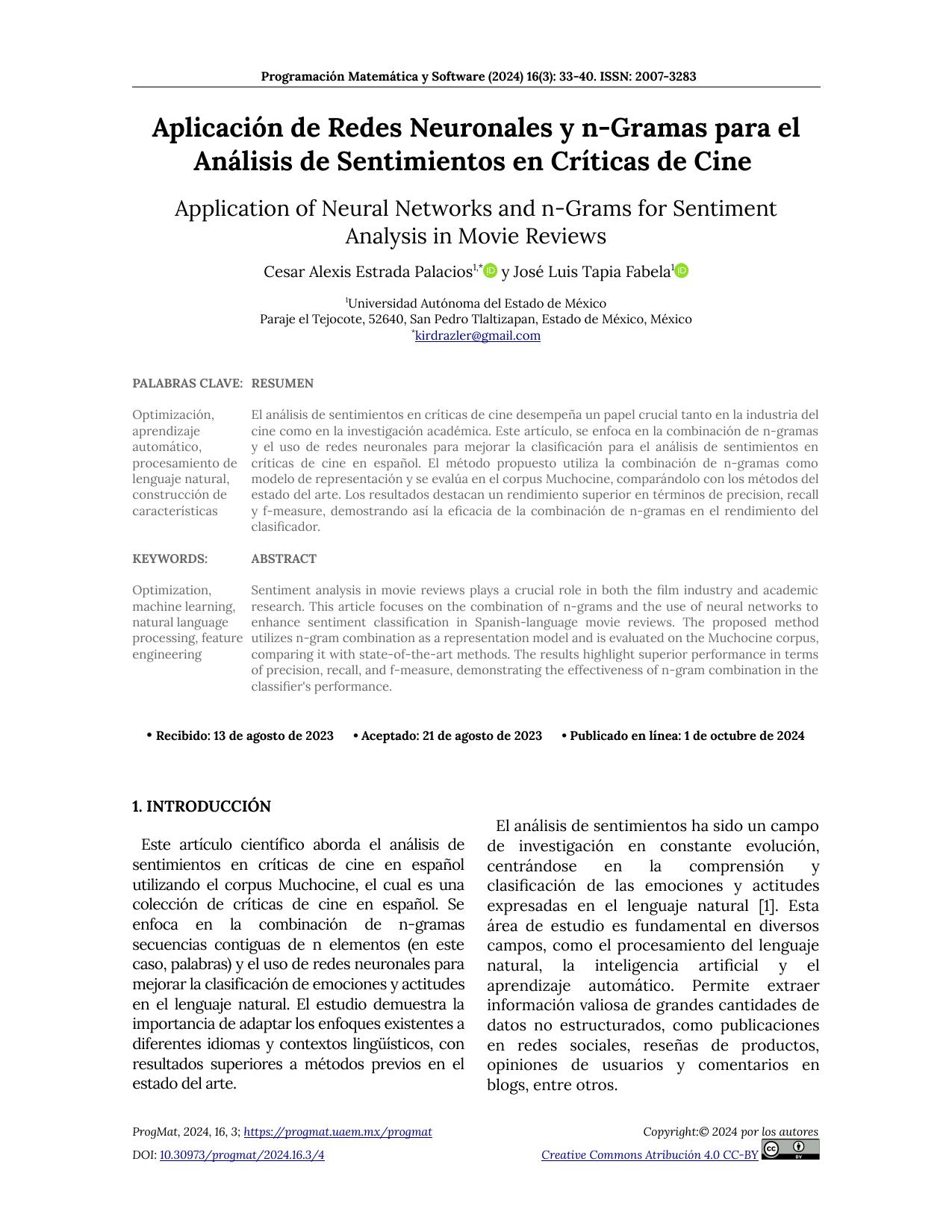Application of Neural Networks and n-Grams for Sentiment Analysis in Movie Reviews
DOI:
https://doi.org/10.30973/progmat/2024.16.3/4Keywords:
Optimization, Machine Learning, Natural Language Processing, Feature EngineeringAbstract
Sentiment analysis in movie reviews plays a crucial role in both the film industry and academic research. This article focuses on the combination of n-grams and the use of neural networks to enhance sentiment classification in Spanish-language movie reviews. The proposed method utilizes n-gram combination as a representation model and is evaluated on the Muchocine corpus, comparing it with state-of-the-art methods. The results highlight superior performance in terms of precision, recall, and f-measure, demonstrating the effectiveness of n-gram combination in the classifier's performance.
References
Liu B. Sentiment Analysis and Opinion Mining. Synthesis Lectures on Human Language Technologies. 2012. Morgan & Claypool Publishers: San Rafael, California. EU. https://doi.org/10.1007/978-3-031-02145-9
Sprout Social. El índice de Sprout Social Q3 2016. 2016. Disponible en https://sproutsocial.com/insights/data/es-3t-de-2016/
Cervantes I. EL ESPAÑOL EN EL MUNDO 2021. Anuario del Instituto Cervantes. 2021, Instituto Cervantes: Madrid, España.
Kim S, Koh Y, Cha J, Lee S. Effects of social media on firm value for U.S. restaurant companies. International Journal of Hospitality Management. 2015, 49, 40-46. https://doi.org/10.1016/j.ijhm.2015.05.006
Collobert R, Weston J, Bottou L, Karlen M, Kavukcuoglu K, Kuksa P. Natural Language Processing (Almost) from Scratch. Journal of Machine Learning Research. 2011, 12, 2493-2537,
Cruz FL, Troyano JA, Enriquez F, Ortega J. Clasificación de documentos basada en la opinión: Experimentos con un corpus de críticas de cine en español. Procesamiento del Lenguaje Natural, 2008, 41, http://journal.sepln.org/sepln/ojs/ojs/index.php/pln/article/view/2551
Martínez-Cámara E, Martín-Valdivia MT, Ureña-López LA. Opinion Classification Techniques Applied to a Spanish Corpus. En Muñoz R, Montoyo A, Métais E. (eds). 16th Int. Conf. on Applications of Natural Language to Information Systems, NLDB 2011. 2011, Springer: Alicante, Spain, LNCS, 6716. https://doi.org/10.1007/978-3-642-22327-3_17
Sari Y, Stevenson M, Vlachos A. Topic or Style? Exploring the Most Useful Features for Authorship Attribution. Proc. of the 27th Int. Conf. on Computational Linguistics, 2018. 343-353. http://www.aclweb.org/anthology/C18-1029
Dubiau L, Ale, JM. Análisis de Sentimientos sobre un Corpus en Español: Experimentación con un Caso de Estudio. XIV Argentine Symposium on Artificial Intelligence (ASAI)-JAIIO. SADIO: Cordoba, Argentina, 2013. 36-47.
Estrada CA, Fabela JLT. Nuevo método para atribución de autoría en muestras de entrenamiento balanceadas y desbalanceadas del corpus C10. Research in Computing Science. 2022, 151(7), 51–62.

Published
How to Cite
Issue
Section
License
Copyright (c) 2024 Cesar Alexis Estrada Palacios, José Luis Tapia Fabela

This work is licensed under a Creative Commons Attribution 4.0 International License.
Usted es libre de:
 |
Compartir — compartir y redistribuir el material publicado en cualquier medio o formato. |
 |
Adaptar — combinar, transformar y construir sobre el material para cualquier propósito, incluso comercialmente. |
Bajo las siguientes condiciones:
 |
Atribución — Debe otorgar el crédito correspondiente, proporcionar un enlace a la licencia e indicar si se realizaron cambios. Puede hacerlo de cualquier manera razonable, pero de ninguna manera que sugiera que el licenciador lo respalda a usted o a su uso. |
| Sin restricciones adicionales: no puede aplicar términos legales o medidas tecnológicas que restrinjan legalmente a otros a hacer cualquier cosa que permita la licencia. |









